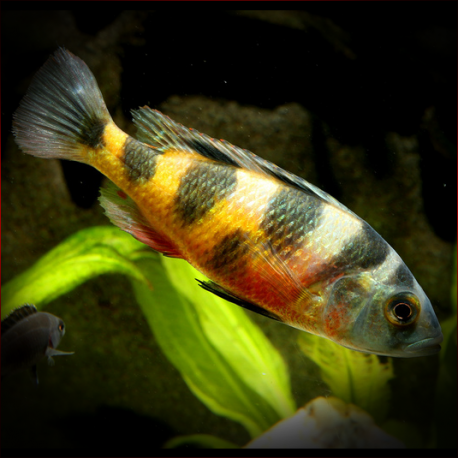More info
Datasheet
| Minimum Tank Size | 110 litres / 29.06 US gallons |
| Maximum Size | 12.5cm / 4.92inches |
| Temperature | 23°C / 73.40°F - 28°C / 82.40°F |
| Hardness | 8-15ºdH |
| pH | 7.2-8.2 |
General Description
Haplochromis Latifasciatus, also known as the Zebra Obliquidens, is a critically endangered species found in Lake Kyoga and Lake Nawampasa in Uganda. The species, though at risk in the wild, is relatively common in the aquarium trade. The male fish are slightly larger and more colorful than the females.
Aquarium Setup
For optimal care, a tank of at least 110 liters is recommended, with hard water (8-15 dH), pH levels between 7.2 to 8.2, and a temperature range of 23-28°C. The aquarium setup should include rock formations creating caves and open water areas with a sandy substrate. While they do not harm vegetation, hard water-tolerant plants like Anubias or Vallisneria can be added.
Behaviour
Haplochromis Latifasciatus can display aggression, especially during spawning. They can be housed with similarly sized Mbuna and peaceful species like Aulonocara or Neolamprologus but should not be kept with related species to prevent hybridization. Males can be vigorous in pursuing mates, so maintaining several females to each male is recommended.
Feeding and Diet
These cichlids accept a variety of foods, but live and frozen options should form the majority of their diet. Offering a mix of live and frozen varieties will help ensure their nutritional needs are met.
Reproduction & Dimorphism
Reproduction in Haplochromis Latifasciatus involves maternal mouthbrooding. A species tank with a male and at least three females is ideal for breeding. The female carries the brood for up to three weeks before releasing free-swimming fry. Males exhibit intense coloration during breeding displays.
Habitat and Distribution
Found in the lakes of Uganda, specifically Lake Kyoga and the adjacent Lake Nawampasa, which are progressively merging due to environmental degradation. Lake Kyoga is shallow with heavily vegetated margins, facing challenges like eutrophication due to pollution from deforestation activities in the surrounding areas.

